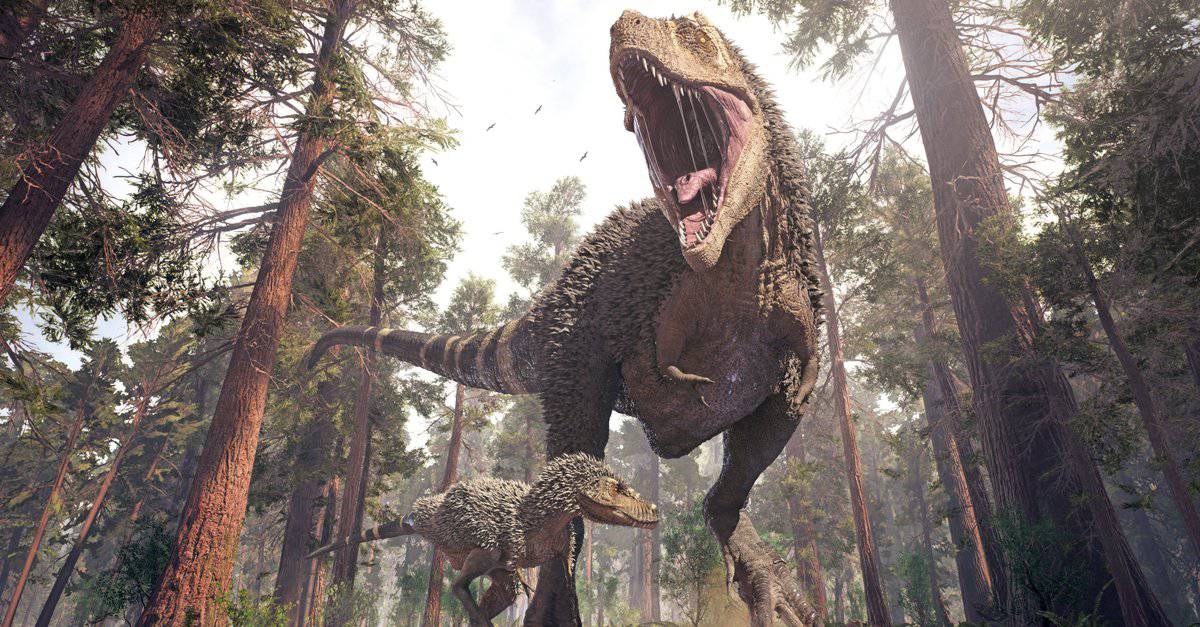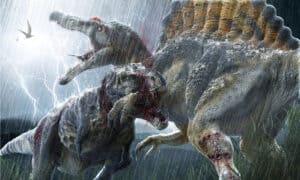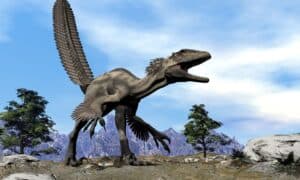People tend to think of the T-rex as the biggest, meanest dinosaur to ever walk the planet. While they may be right, a few other powerful dinosaurs were actually larger than the massive theropod. The Spinosaurus is believed to be the largest carnivorous dinosaur in the world’s history. Yet, that doesn’t mean it can immediately be considered the deadliest. The Giganotosaurus was another massive dinosaur that could go toe-to-toe with the T-Rex. With that in mind, let’s consider a Giganotosaurus vs Spinosaurus matchup and see who wins among the true giants of the ancient world.
We can look at this fight from many different perspectives and show you how this battle would end.
Comparing a Giganotosaurus and a Spinosaurus
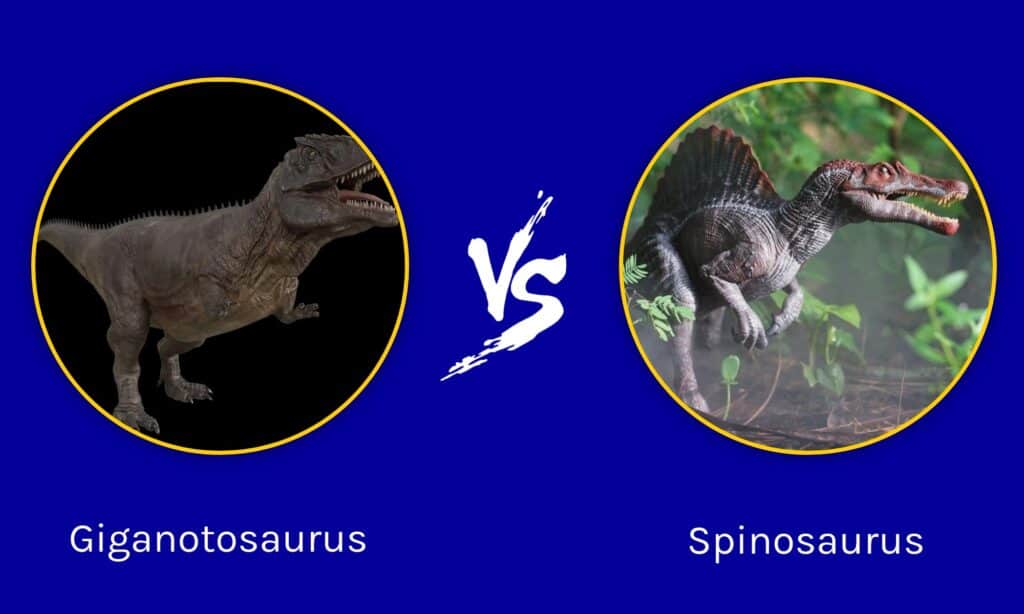
| Giganotosaurus | Spinosaurus | |
|---|---|---|
| Size | Weight: 8,400 -17,600lbs – Possibly up to 30,000lbs Height: 12-20ft Length 45ft | Weight: 15,000lbs 31,000lbs Height: 23ft Length: 45-60 feet |
| Speed and Movement Type | – 31 mph – Bipedal striding | – 15 mph – Bipedal striding |
| Defenses | – Large size – Quick movement speed – Good senses to detect movement and other creatures | – Massive size – Ability to attack creatures in the water |
| Offensive Capabilities | -6,000 PSI bite power, perhaps higher -76 serrated teeth – 8-inch teeth – Sharp claws – Ability to ram and knock over foes | – 4,200 PSI (up to 6,500 PSI) – 64 straight, conical teeth, similar to modern crocodiles – Teeth up to 6in long – Powerful bites – Ability to chase prey in and out of the water |
| Predatory Behavior | – Likely would attack large prey with teeth and claws and wait for them to bleed to death – May have worked in groups with others | – Was possibly a semi-aquatic dinosaur that ambushed prey at the water’s edge – Could successfully chase other large theropods |
What Are Key Differences Between a Giganotosaurus and a Spinosaurus?
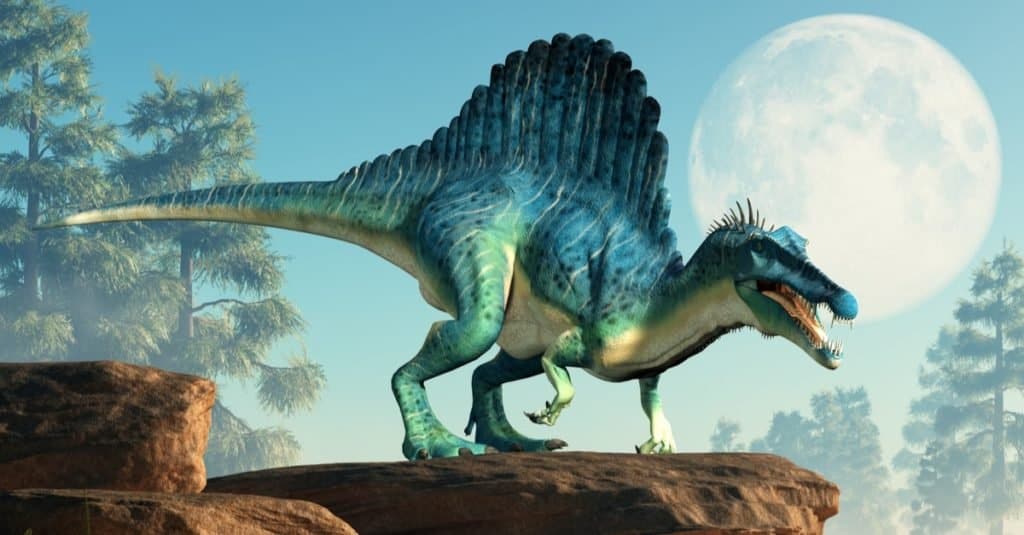
The key differences between a Giganotosaurus and a Spinosaurus lie in their morphology and size.
©Daniel Eskridge/Shutterstock.com
The key differences between a Giganotosaurus and a Spinosaurus lie in their morphology and size. The Giganotosaurus was a bipedal theropod with large powerful legs, a unique flattened lower jaw, a large skull, small arms, and a long tail that weighed up to 17,600lbs, stood nearly 20ft tall, and measured 45ft long, but the Spinosaurus was a semi-aquatic biped that weighed up to 31,000lbs, stood 23ft tall, and measured 60ft long with a massive spinal fin, paddle-like tail, and a long skull.
These differences are massive, and they will certainly inform the outcome of the fight. However, we need to look at more information to decide which animal is going to win this battle.
What Are the Key Factors in a Fight Between a Giganotosaurus and a Spinosaurus?
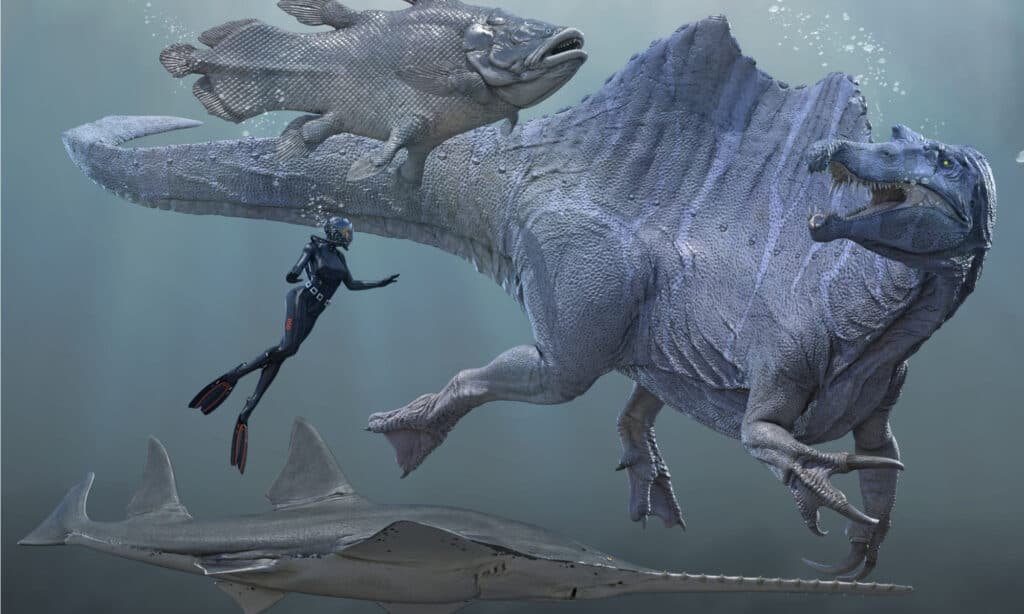
Spinosaurus was a semi-aquatic dinosaur that hunted prey in the water, while the Giganotosaurus remained on land.
©Herschel Hoffmeyer/Shutterstock.com
The most important factors in a fight between the Giganotosaurus and Spinosaurus will mirror the same elements that are significant in other dinosaur battles. We must compare size, predatory behaviors, movement, and more. With these factors fully explored, we can decide which creature would win the fight.
Giganotosaurus vs Spinosaurus: Size
The Spinosaurus was larger than the Giganotosaurus, but we don’t know by how much of a margin. Some reconstructions pin the Spinosaurus as weighing as much as 31,000lbs and others say it was closer to 20,000lbs. Either way, we know this creature stood about 23ft tall including its massive spinal fin, and measured about 50ft to60ft.
The Giganotosaurus was also very large, weighing between 8,400lbs and 17,600lbs or up to 30,000lbs based on some estimates. This dinosaur stood between 12ft and 20ft and measured 45ft long including its massive tail.
Spinosaurus had the size advantage in this fight.
Giganotosaurus vs Spinosaurus: Speed and Movement
The Giganotosaurus was faster than the Spinosaurus on land, but Spinosaurus was faster than Giganotosaurus in the water. New models suggest that Spinosaurus was more of a semi-aquatic creature that used its paddle-like tail and long arms to help it swim and catch prey in bodies of water.
Either way, the Giganotosaurus may have hit speeds of 31 mph on land and the Spinosaurus may have reached speeds of 15 mph. We lack information about their water speeds, though.
Giganotosaurus has the speed advantage on land, but it’s doubtful that it maintained this advantage in the water.
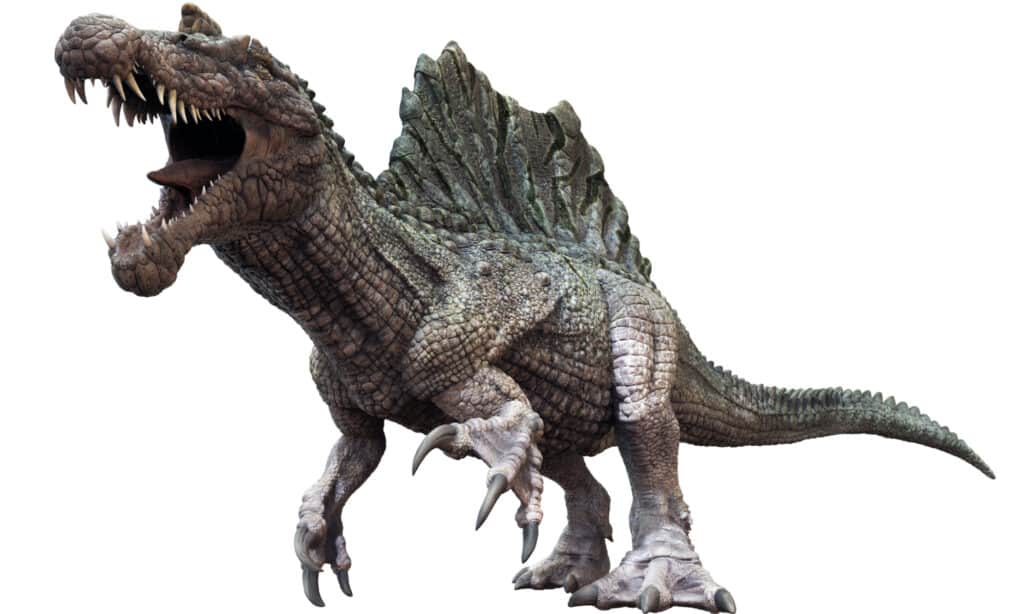
The Spinosaurus moved between land and water, while the Giganotosaurus had its size to protect it.
©Herschel Hoffmeyer/Shutterstock.com
Giganotosaurus vs Spinosaurus: Defenses
The Giganotosaurus was like most dinosaurs in that it had its massive size to keep it safe. However, it also had a relatively fast movement speed along with good senses to detect other animals.
The Spinosaurus could move between land and water, allowing it to go to a place where it had an advantage over others. Moreover, this dinosaur had a simply immense size that would make most creatures stay away.
In short, both dinosaurs were apex predators, so they were usually the meanest creatures walking around and didn’t have to worry much once they were fully grown.
Giganotosaurus vs Spinosaurus: Offensive Capabilities
The Spinosaurus was a massive dinosaur with a strong bite that was similar to that of a modern-day crocodile. This dinosaur relied on its bite to kill its prey. Their mouths were packed with 64 conical, teeth measuring up to 6 inches long. They were used to bite and hold prey. Their bite power measured between 4,200 and 6,500 PS, so it could deliver a deadly bite to foes.
Giganotosaurus also inflicted deadly bites on its foes. This dinosaur had a 6,000 PSI bite force and 76 serrated teeth that measured 8 inches in length behind every bite. Also, this dinosaur had sharp claws and the ability to ram and knock over other creatures.
Giganotosaurus had the offensive advantage for its simple yet brutal attack methods.
Giganotosaurus vs Spinosaurus: Predatory Behavior
The Giganotosaurus may have hunted with other members of its species when it was young, but an adult likely hunted alone. These dinosaurs were large enough to use their body weight while hunting, ramming into enemies and knocking them over before commencing their assault.
Giganotosaurus favored an “attack and wait” technique where it would inflict bites and slashes on prey and then wait for them to weaken before resuming the attack. It’s not clear if this dinosaur would ambush other animals or simply use opportunistic predation.
The Spinosaurus’ bone density and other factors probably limited its ability to hunt in deep water. This dinosaur probably only hunted close to the shoreline. Nevertheless, Spinosaurus could effectively hunt on land and in the water, even pursuing and killing other theropods.
Giganotosaurus was probably the more effective hunter on land, but Spinosaurus clearly benefitted from being able to hunt on land and in the water.
Who Would Win in a Fight Between a Giganotosaurus and a Spinosaurus?
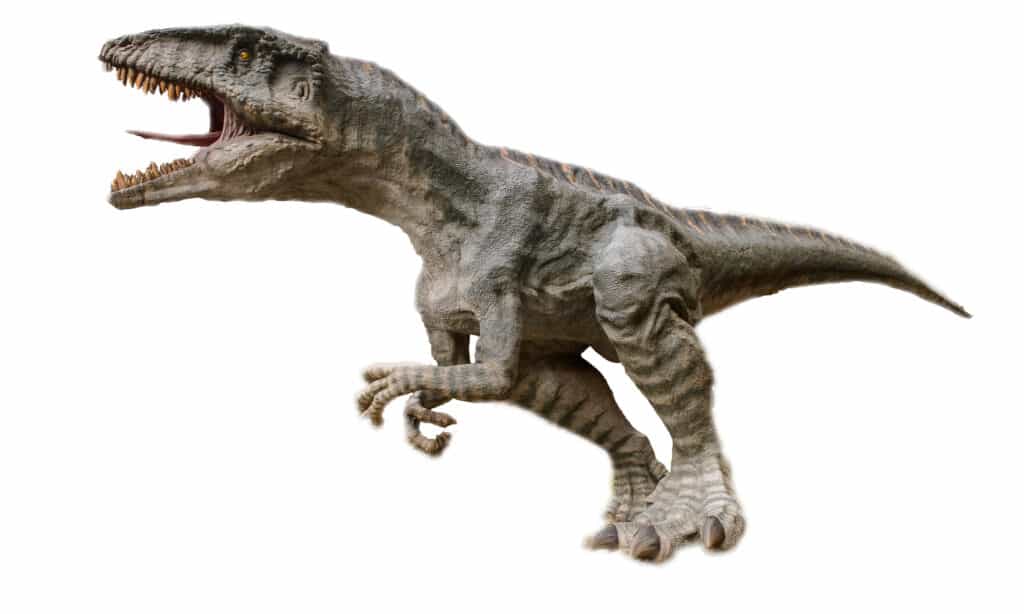
The Giganotosaurus was a powerhouse, and it would take down the Spinosaurus.
©Anton_Ivanov/Shutterstock.com
A Giganotosaurus would win a fight against a Spinosaurus. We can’t mistake the large size of the Spinosaurus for the ability to kill another massive dinosaur. Also, the Giganotosaurus may have been nearly half the weight of the Spinosaurus, or it may have weighed nearly the same.
So, the Giganotosaurus was fantastic at hunting on land. It would not go into the water to fight Spinosaurus where the semi-aquatic dinosaur had the advantage. Given that this fight would happen entirely on land, Giganotosaurus would be better suited to win the fight.
Giganotosaurus would use its speed to smash into the other dinosaur and land deadly, flesh-ripping bites on it. The Spinosaurus’s bite was strong, but its teeth were built to grab and hold smaller prey, not take down massive theropods.
The Giganotosaurus would be too much for the Spinosaurus to fend off in this fight.
Thank you for reading! Have some feedback for us? Contact the AZ Animals editorial team.

